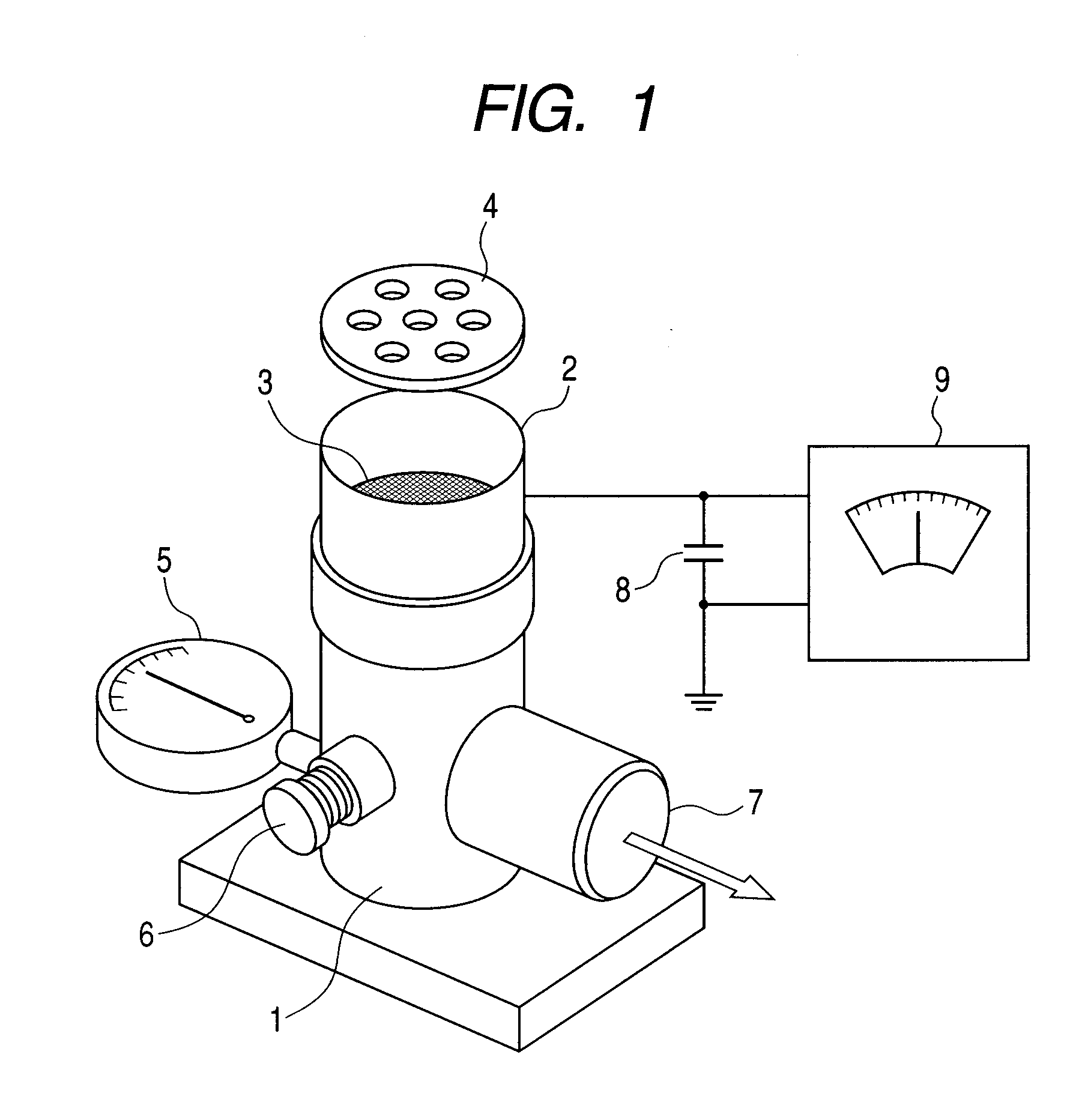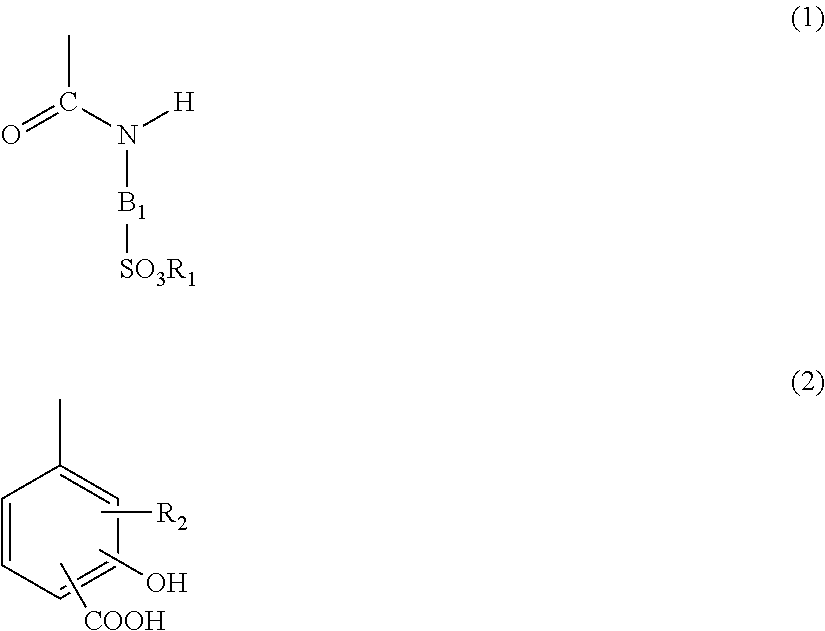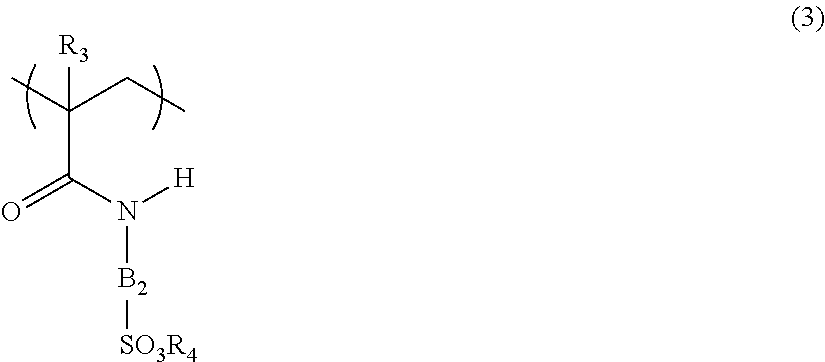Resin for toners, and toner
a technology for toners and toners, applied in the field of toners, can solve the problems of insufficient charging performance and charging rise performance at the initial stage of running, and achieve the effect of short and superior quickness
- Summary
- Abstract
- Description
- Claims
- Application Information
AI Technical Summary
Benefits of technology
Problems solved by technology
Method used
Image
Examples
example 1
[0213]Into a reaction vessel provided with a stirrer, a condenser, a thermometer and a nitrogen feed pipe, 60.00 parts of toluene was fed, and was refluxed in a stream of nitrogen.
[0214]Next, the following monomers and solvent were mixed to prepare a monomer mixture.
[0215]Monomer Composition & Mixing Ratio:
Monomer 5A21.00 partsMonomer 6A18.00 partsStyrene61.00 partsToluene60.00 parts
[0216]Into this monomer mixture, 6.60 parts of t-butyl peroxyisopropyl monocarbonate (a 75% hydrocarbon type solvent dilute product) as a polymerization initiator was further mixed, and the mixture obtained was dropwise added to those in the above reaction vessel over a period of 30 minutes. Its contents were stirred at 110° C. for 4 hours, and then cooled to room temperature. The polymer-containing composition obtained was dropwise added to a mixed solvent of 1,400 parts of methanol and 10 parts of acetone over a period of 10 minutes with stirring, to precipitate and crystallize a resin composition. The...
example 14
[0219]Into a reaction vessel provided with a cooling pipe, a stirrer, a thermometer and a nitrogen feed pipe, 90.0 parts of propylene glycol, 103.8 parts of terephthalic acid, 5 parts of trimellitic acid, 10.0 parts of adipic acid, 24.0 parts of maleic anhydride and 2.0 parts of tetrastearyl titanate as a condensation catalyst were introduced to carry out reaction for 6 hours while evaporating off the water being formed, at 230° C. in a stream of nitrogen. Next, the reaction was carried out for 8 hours under a reduced pressure of from 5 mmHg to 20 mmHg to obtain an unsaturated polyester resin 1. This unsaturated polyester resin 1 had an acid value of 35.4 mgKOH / g, a hydroxyl value of 10.1 mgKOH / g, an Mn of 2,300 and an Mw of 4,500.
[0220]Into a reaction vessel provided with a cooling pipe, a stirrer, a thermometer and a nitrogen feed pipe, 100 parts of the above unsaturated polyester resin 1 and 20 parts of 2-amino-5-methoxybenzenesulfonic acid were introduced, and 400 parts of pyrid...
example 15
[0223]A polymer O was obtained in the same way as in Example 14 except that, in Example 14, 2-aminobenzenesulfonic acid was used therein in place of the 2-amino-5-methoxybenzenesulfonic acid and that the monomer 6D was used therein in place of the monomer 6A. It was ascertained from the results of 1H-NMR that the polymer O obtained contained a sulfonic acid unit represented by the following formula (IG) and a unit of a salicylic acid structure represented by the following formula (2D). It was ascertained by measurement of sulfur atom level in the polymer that the unit represented by the formula (1G) was present in an amount of 8.20% by mass. The polymer 0 had an acid value of 51.5 mgKOH / g, and it was also ascertained from the acid value that the unit represented by the formula (2D) was present in an amount of 4.50% by mass. The polymer had an Mn of 3,700 and an Mw of 8,600.
PUM
| Property | Measurement | Unit |
|---|---|---|
| temperature | aaaaa | aaaaa |
| temperature | aaaaa | aaaaa |
| glass transition point | aaaaa | aaaaa |
Abstract
Description
Claims
Application Information
 Login to View More
Login to View More - R&D
- Intellectual Property
- Life Sciences
- Materials
- Tech Scout
- Unparalleled Data Quality
- Higher Quality Content
- 60% Fewer Hallucinations
Browse by: Latest US Patents, China's latest patents, Technical Efficacy Thesaurus, Application Domain, Technology Topic, Popular Technical Reports.
© 2025 PatSnap. All rights reserved.Legal|Privacy policy|Modern Slavery Act Transparency Statement|Sitemap|About US| Contact US: help@patsnap.com



